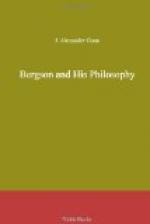In the paper read before the First International Congress of Philosophy at Paris in 1900, on Our Belief in the Law of Causality,[Footnote: Notre croyance a la loi de causalite (Revue de metaphysique et de morale, Sept., 1900, pp. 655-660).] Bergson showed that it has its root in the co-ordination of our tactile impressions with our visual impressions. This co-ordination becomes a continuity which generates motor habits or tendencies to action.
There now comes up for consideration the question as to why this relation of the organism, to more or less distinct objects, takes the particular form of conscious perception, and further, why does everything happen as if this consciousness were born of the internal movements of the cerebral substance? To answer this question, we must turn to perceptual processes, as these occur in our everyday life. We find at once that “there is no perception which is not full of memories. With the immediate and present data of our senses, we mingle a thousand details out of our past experience."[Footnote: Matter and Memory, p. 24 (Fr. p. 20).] To such an extent is this true that the immediate data of perception serve as a sign to bring much more to the mind. Psychological experiments have conclusively proved that we never actually perceive all that we imagine to be there. Hence arise illusions, examples of which may be easily thought of—incorrect proof-reading is one, while another common one is the mistake of taking one person for another because of some similarity of dress. What is actually perceived is but a fraction of what we are looking at and acts normally as a suggestion for the whole. Now, although it is true that, in practice, Perception and Memory are never found absolutely separate in their purity, yet it is necessary to distinguish them from one another absolutely in any investigation of a psychological nature. If, instead of a perception




